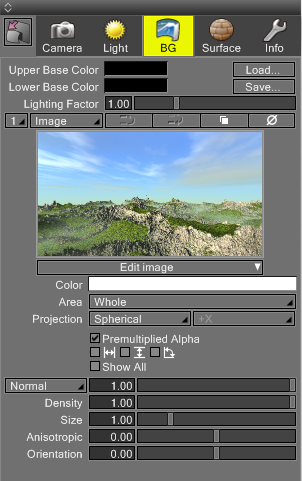Background Window
Select View > Background or click the BG tab of the Aggregate Window to open the Background Window. The Background Window is used to specify various settings of the background.

- Upper Base Color
- The base color for the upper hemisphere. A mapping pattern or image can be blended with this base color. Use the Blend pop-up menu to select a blend mode.
- Lower Base Color
- The base color for the lower hemisphere. A mapping pattern or image can be merged with this base color. Use the Blend pop-up menu to select a blend mode.
- Load... Button
- Loads a background settings file (.shdbgr, .xmlshdbgr).
- Save... Button
- Saves the current Background Window settings as a background settings file (.shdbgr, .xmlshdbgr).
- Lighting Factor
- When using image-based lighting (IBL), sets the relative brightness of the background as a light source. To use image-based lighting, in the Image Window select Path Tracing or Path Tracing + Photon Mapping from the Global Illumination pop-up menu (G.I. tab). The Reflect Background checkbox on the Basics tab must also be selected.
- Layer Pop-up Menu
- Specifies the layer index for the settings. Select New Layer to add a new layer. The weight and blend mode can be set differently for individual layers for multi-layer mapping.
- Pattern Pop-up Menu
- Specifies the pattern used for the selected layer.
- Move Layer Buttons
- Clicking
 will move the selected distant light up one layer.
will move the selected distant light up one layer.
Clicking will move the selected distant light down one layer.
will move the selected distant light down one layer. - Duplicate Layer
- Clicking
 will copy the selected distant light layer. The new layer is added at the bottom.
will copy the selected distant light layer. The new layer is added at the bottom. - Delete Layer
- Clicking
 will delete the selected distant light layer.
will delete the selected distant light layer. - Preview
- Shows a preview of the background using the current Background Window settings. By default only the selected layer is shown in the preview. To preview all layers blended together, select the Show All checkbox.
- Edit Image Pop-up Menu
- Click to open a menu for working with the image used for the selected background layer.
Note In addition to the above menu items, in Shade3D Standard and Professional plugin options will be available. These options allow plugin features to be applied to the image.
- Color
- Specifies the pattern color used for the selected layer. This color is also used for any borders added in the Crop Area Setting dialog.
- Area
- Select Whole, Upper, or Lower for the area to apply the background.
- Projection Pop-up Menu
- When mapping a pattern to the background, different projection methods can be used. Choose between Planar, Spherical, Light Probe, Cube Map, and Vertical Cross. The available projection methods depend on the pattern selected. If the projection method name is dimmed, it cannot be used for the selected pattern. For the Light Probe projection, the pole can be specified via the adjacent Pole pop-up menu.
- Pole Pop-up Menu
- This menu becomes available when Light Probe is selected as the projection method. Here you can specify the pole used for mapping.
- Premultiplied Alpha
- This option becomes available when Image is selected as the background pattern.
When selected, the layer alpha channel is ignored and the layer color is blended with the upper or lower base color or pattern underneath.
When unselected, the pixel alpha channel value is multiplied with the Mapping Weight value.  Horizontal Flip
Horizontal Flip- This option becomes available when Image is selected as the background pattern. When selected, the image is flipped horizontally.
 Vertical Flip
Vertical Flip- This option becomes available when Image is selected as the background pattern. When selected, the image is flipped vertically.
 Switch Axes
Switch Axes- This option becomes available when Image is selected as the background pattern. When selected, the image's horizontal and vertical axes are switched.
- Show All
- When selected, the blend of all background layers is shown in the preview.
When unselected, only a preview of the currently selected background layer is shown. - Blend Pop-up Menu
- Specifies the blend mode used for multiple layers.
- Mapping Weight Slider and Text Box
- Specifies the weight given to the selected background layer.
- Density
- The density of clouds. (Only used when Cloud is selected for the pattern.) Smaller values will result in a sky with few clouds.
- Size
- The size of the pattern.
- Anisotropic
- The directionality of the pattern.
- Orientation
- The horizontal orientation of the pattern.